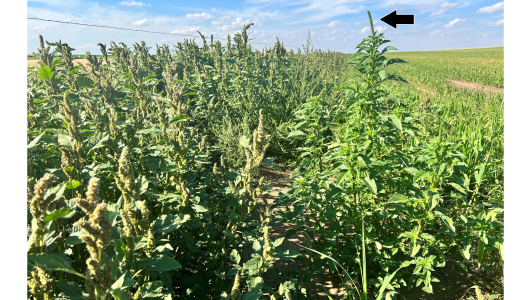
New Population of Palmer Amaranth Detected in Montana: Be on the Lookout for Palmer Amaranth and Waterhemp this Fall
Summary
Palmer amaranth (Amaranthus palmeri) was confirmed in Daniels County, Montana in September 2023. This is the second confirmed occurrence of this species in Montana, and the first time it has been documented in an agricultural field in our state. Be on the lookout for this species and its close relative waterhemp (Amaranthus tuberculatus) this fall.
 Among the pigweeds in this photo, the Palmer amaranth plant (designated by the black arrow), stands out due to its long, thin inflorescence (Photo; Inga Hawbaker, Daniels County Extension). |
Palmer Amaranth and Waterhemp in Montana
Palmer amaranth and waterhemp (Amaranthus tuberculatus) are both pigweed species that have limited known distribution in Montana. Both species have evolved genotypes resistant to multiple herbicide modes of action. If they become established, these two species will have a large economic impact on Montana agriculture. Both weeds have the potential to establish in warm season crops such as corn and millet, and also irrigated sugarbeets, cereal, and pulse crops, but have also been associated with birdfeed.
In September 2023 several flowering Palmer amaranth plants were found growing in a field in Daniels County associated with contaminated millet seed. The plants were removed from the field prior to seed production. Two waterhemp populations have also been found in eastern Montana in recent years. One was detected in an irrigated durum field in Roosevelt County in 2020, and a few plants were found in a sugarbeet field in Prairie County in 2021. Also of note, Palmer amaranth was detected for the first time in Idaho this year.
Now is a good time of year to scout fields for Palmer amaranth and waterhemp because they are easier to locate and identify when they are flowering. Special attention should be given to scouting warm season forages and irrigated fields. Look for large pigweeds with long, thin inflorescences compared with more common relatives like redroot pigweed.
Early detection and rapid response are critical to contain these weeds and prevent populations from establishing, so learn to identify them, take action to manage and control spread as needed, and learn to recognize potential vectors. Identification can be difficult, but these MontGuides can help identify the different pigweeds (Palmer amaranth and Waterhemp).
Contact your local Extension office or agronomist if you suspect you have found either of these species or if you have questions about pigweed identification. You can also visit the Palmer amaranth task force webpage for more information.
Contact Cropland Weed Extension Specialist Tim Seipel ([email protected]) or Noelle Orloff from the Schutter Diagnostic Lab ([email protected]) with additional questions.